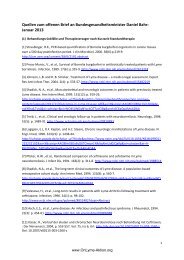Offenen Brief mit über 7000 Mitunterzeichnern - OnLyme Aktion
Offenen Brief mit über 7000 Mitunterzeichnern - OnLyme Aktion
Offenen Brief mit über 7000 Mitunterzeichnern - OnLyme Aktion
Sie wollen auch ein ePaper? Erhöhen Sie die Reichweite Ihrer Titel.
YUMPU macht aus Druck-PDFs automatisch weboptimierte ePaper, die Google liebt.
Monica E. Embers, 1,* Stephen W. Barthold, 4 Juan T. Borda, 2 Lisa Bowers, 1 Lara Doyle, 3 Emir Hodzic, 4 Mary B.<br />
Jacobs, 1 Nicole R. Hasenkampf, 1 Dale S. Martin, 1 Sukanya Narasimhan, 5 Kathrine M. Phillippi‐Falkenstein, 3<br />
Jeanette E. Purcell, 3,¤ Marion S. Ratterree, 3 and Mario T. Philipp 1,* (2012), Persistence of Borrelia burgdorferi<br />
in Rhesus Macaques following Antibiotic Treatment of Disseminated Infection, PLoS One. 2012; 7(1):<br />
e29914. doi: 10.1371/journal.pone.0029914 PMCID: PMC3256191<br />
R K Straubinger, B A Summers, Y F Chang, M J Appel, (1997), Persistence of Borrelia burgdorferi in<br />
experimentally infected dogs after antibiotic treatment. J Clin Microbiol. 1997 January; 35(1): 111–116.<br />
PMCID: PMC229521<br />
Hodzic E, Feng S, Holden K, Freet KJ, Barthold SW. (2008), Persistence of Borrelia burgdorferi following<br />
antibiotic treatment in mice. Antimicrob Agents Chemother ;52(5):1728‐36. doi: 10.1128/AAC.01050‐07.<br />
Barthold SW, Hodzic E, Imai DM, Feng S, Yang X, Luft BJ. (2010), Ineffectiveness of tigecycline against<br />
persistent Borrelia burgdorferi, Antimicrob Agents Chemother; 54(2):643‐51. doi: 10.1128/AAC.00788‐09.<br />
Yrjänäinen H, Hytönen J, Hartiala P, Oksi J, Viljanen MK. Persistence of borrelial DNA in the joints of Borrelia<br />
burgdorferi‐infected mice after ceftriaxone treatment. (2010), APMIS; 118(9):665‐73. doi: 10.1111/j.1600‐<br />
0463.2010.02615.x.<br />
Logigian EL et al, (1990), Chronic neurologic manifestation of Lyme disease, N. Engl. J.med. 323, 1438‐1444<br />
N. A. Shadick, C. B. Phillips, E. L. Logigian, et al., (1994) The long‐term clinical outcomes of Lyme disease. A<br />
population‐based retrospective cohort study, Annals of Internal Medicine, vol. 121, no. 8, pp. 560–567<br />
H. Yrjänäinen, J. Hytönen, K.‐O. Söderström, J. Oksi, K. Hartiala, and M. K. Viljanen, (2006) Persistent joint<br />
swelling and borrelia‐specific antibodies in Borrelia garinii‐infected mice after eradication of vegetative<br />
spirochetes with antibiotic treatment, Microbes and Infection, vol. 8, no. 8, pp. 2044–2051<br />
Die Frage bei persistierender Lyme‐Borreliose ist nicht, was ist <strong>mit</strong> den 50 bis 76 %, bei denen die<br />
kurze Standardtherapie offenbar erfolgreich ist. Die Frage ist, wie müssen jene 24 % bis 50 %<br />
behandelt werden, bei denen diese Kurzzeittherapie nicht ausreichend anschlägt<br />
Studie<br />
Battafarano et al. 1993 [1]<br />
Bayer 1996 [2]<br />
Bradley et al. 2001<br />
Breier et al. 2001 [4]<br />
Haupl et al. 1993 [5]<br />
Lawrence et al. [6]<br />
Liegner et al. 1993 [7]<br />
Kommentar<br />
Patienten, die seit 7 Jahren an einer chron. Lyme-Arthritis des Knies<br />
leiden, trotz multipler antibiotischer Therapien und Synovektomie. Bb<br />
wurde dennoch im Synovium und Gelenkflüssigkeit gefunden.<br />
97 Patienten, die für längere Zeit antibiotisch behandelt wurden litten<br />
weiter an Symptomen einer chron. Borreliose und waren PCR-positiv.<br />
Zwei zuvor antibiotisch behandelte Borreliose-Patienten sind<br />
anschließend immer noch PCR-positiv (Bb in der Gelenkflüssigkeit).<br />
Trotz einer viermaligen Therapie <strong>mit</strong> Ceftriaxon: „Spirochäten konnten<br />
aus Hautkulturen einer sich vergrößernden LSA-Läsion gewonnen<br />
werden (…) die Serologie war wiederholt negativ.“<br />
Es wurde eine wiederholte antibiotische Therapie notwendig, um das<br />
Fortschreiten der Erkrankung zu stoppen, doch Bb konnte nicht<br />
komplett eliminiert werden. Bb konnte anschließend wieder aus einer<br />
Ligament-Probe angezüchtet werden.<br />
Der Liquor der Patienten war Bb-Antigen-Antikörper-Komplex<br />
(Immunkomplex) positiv, positiv auf Bb-Nukleinsäure und freie Antigene<br />
trotz aggressiver antibiotischer Therapie.<br />
11 Monate nach der Therapie waren Bb-Antigene in der T-Cell<br />
http://<strong>OnLyme</strong>-<strong>Aktion</strong>.org<br />
33








